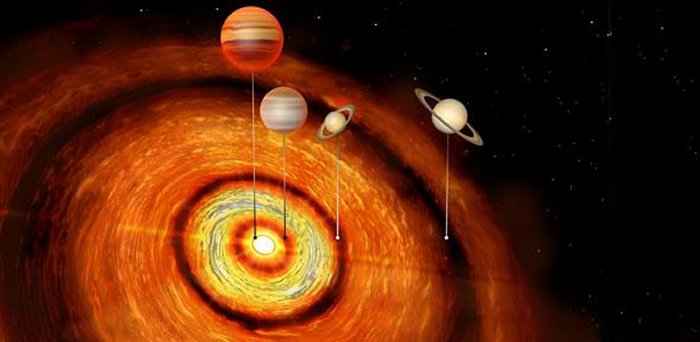MessageToEagle.com – Researchers led by the University of Cambridge, have used the Atacama Large Millimeter/submillimeter Array (ALMA) to identify a young star with four Jupiter and Saturn-sized planets in orbit around it, the first time that so many massive planets have been detected in such a young system.
The star is just two million years old — a ‘toddler’ in astronomical terms — and is surrounded by a huge disc of dust and ice. This disc, known as a protoplanetary disc, is where the planets, moons, asteroids and other astronomical objects in stellar systems form.

The star, CI Tau, is located about 500 light years away in a highly-productive stellar ‘nursery’ region of the galaxy. Its four planets differ greatly in their orbits: the closest (the hot Jupiter) is within the equivalent of the orbit of Mercury, while the farthest orbits at a distance more than three times greater than that of Neptune.
The two outer planets are about the mass of Saturn, while the two inner planets are respectively around one and 10 times the mass of Jupiter.
The discovery – described in a paper – raises many questions for astronomers. Around 1% of stars host hot Jupiters, but most of the known hot Jupiters are hundreds of times older than CI Tau.
“It is currently impossible to say whether the extreme planetary architecture seen in CI Tau is common in hot Jupiter systems because the way that these sibling planets were detected — through their effect on the protoplanetary disc — would not work in older systems which no longer have a protoplanetary disc,” Professor Cathie Clarke from Cambridge’s Institute of Astronomy, the study’s first author, said in a press release.
According to the researchers, it is also unclear whether the sibling planets played a role in driving the innermost planet into its ultra-close orbit, and whether this is a mechanism that works in making hot Jupiters in general. And a further mystery is how the outer two planets formed at all.
“Planet formation models tend to focus on being able to make the types of planets that have been observed already, so new discoveries don’t necessarily fit the models,” Clarke said.
. “Saturn mass planets are supposed to form by first accumulating a solid core and then pulling in a layer of gas on top, but these processes are supposed to be very slow at large distances from the star. Most models will struggle to make planets of this mass at this distance.”
MessageToEagle.com






